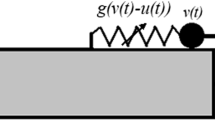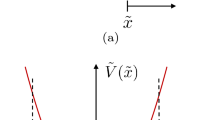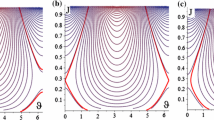Abstract
The paper presents an analytical approach to predicting the safe basins (SBs) in a plane of initial conditions (ICs) for escape of classical particle from the potential well under harmonic forcing. The solution is based on the approximation of isolated resonance, which reduces the dynamics to a conservative flow on a two-dimensional resonance manifold (RM). Such a reduction allows easy distinction between escaping and non-escaping ICs. As a benchmark potential, we choose a common parabolic-quartic well with truncation at varying energy levels. The method allows accurate predictions of the SB boundaries for relatively low forcing amplitudes. The derived SBs demonstrate an unexpected set of properties, including decomposition into two disjoint zones in the IC plane for a certain range of parameters. The latter peculiarity stems from two qualitatively different escape mechanisms on the RM. For higher forcing values, the accuracy of the analytic predictions decreases to some extent due to the inaccuracies of the basic isolated resonance approximation, but mainly due to the erosion of the SB boundaries caused by the secondary resonances. Nevertheless, even in this case the analytic approximation can serve as a viable initial guess for subsequent numeric estimation of the SB boundaries.




















Similar content being viewed by others
Notes
Commonly in scientific software like SciPy or Wolfram Mathematica one needs to square the modulus, i.e., K(k) or F(ϕ| k) in the formula reads as K(k2) or F(ϕ|k2) in the program code.
Abbreviations
- IC:
-
Initial condition
- SB:
-
Safe basin
- RM:
-
Resonance manifold
- AIR:
-
Approximation of isolated resonance
- AA:
-
Action angle
- GIM:
-
Global integrity measure
- SI:
-
Stochastic integrity
- MM:
-
Maximum mechanism
- SM:
-
Saddle mechanism
- SMM:
-
Saddle maximum mechanism
- SBMT:
-
Safe basin of maximum type
- SBST:
-
Safe basin of saddle type
- EC:
-
Excitation cycle
- ESB:
-
Energy safe basin
- DSB:
-
Displacement safe basin
References
Landau, L.D., Lifshitz, E.M., Mechanics: volume 1, vol. 1. Butterworth-Heinemann (1976)
Thompson, J.M.T., Chaotic phenomena triggering the escape from a potential well, p. 319. (1991)
Virgin, L.N.: Approximate criterion for capsize based on deterministic dynamics. Dyn. Stab. Syst. 4(1), 56–70 (1989). https://doi.org/10.1080/02681118908806062
Virgin, L.N., Plaut, R.H., Cheng, C.C.: Prediction of escape from a potential well under harmonic excitation. Int. J. Non-linear Mech. (1992). https://doi.org/10.1016/0020-7462(92)90005-R
Arecchi, F.T., Badii, R., Politi, A.: Scaling of first passage times for noise induced crises. Phys. Lett. A (1984). https://doi.org/10.1016/0375-9601(84)90035-5
Mann, B.P.: Energy criterion for potential well escapes in a bistable magnetic pendulum. J. Sound Vib. (2009). https://doi.org/10.1016/j.jsv.2009.01.012
Bethe, H.A., Brown, G.E., Applegate, J., Lattimer, J.M.: Equation of state in the gravitational collapse of stars. Nucl. Phys. Sect. A (1979). https://doi.org/10.1016/0375-9474(79)90596-7
Barone, A., Paternò, G.: Physics and Applications of the Josephson Effect. Wiley, New York (1982)
Arnold, V.I., Kozlov, V.V., Neishtadt, A.I.: Mathematical Aspects of Classical and Celestial Mechanics. Springer, New York (1993)
DaneQuinn, D.: Transition to escape in a system of coupled oscillators. Int. J. Non-linear. Mech. (1997). https://doi.org/10.1016/s0020-7462(96)00138-2
Belenky, V.L., Sevastianov, N.B., Stability and Safety of Ships: Risk of Capsizing. (2007)
Spyrou, K.J., Thompson, J.M.T.: The nonlinear dynamics of ship motions: A field overview and some recent developments. Philos. Trans. R. Soc. A Math. Phys. Eng. Sci. (2000). https://doi.org/10.1098/rsta.2000.0613
Virgin, L.N.: The nonlinear rolling response of a vessel including chaotic motions leading to capsize in regular seas. Appl. Ocean Res. (1987). https://doi.org/10.1016/0141-1187(87)90011-3
Alsaleem, F.M., Younis, M.I., Ruzziconi, L.: An experimental and theoretical investigation of dynamic pull-in in MEMS resonators actuated electrostatically. J. Microelectromech. Syst. (2010). https://doi.org/10.1109/JMEMS.2010.2047846
Gendelman, O.V., Sapsis, T.P.: Energy exchange and localization in essentially nonlinear oscillatory systems: canonical formalism. J. Appl. Mech. Trans. ASME (2017). https://doi.org/10.1115/1.4034930
Paul, W.: Electromagnetic traps for charged and neutral particles. Rev. Mod. Phys. (1990). https://doi.org/10.1103/RevModPhys.62.531
Gonçalves, P.B., Silva, F.M.A., Rega, G., Lenci, S.: Global dynamics and integrity of a two-dof model of a parametrically excited cylindrical shell. Nonlinear Dyn. (2011). https://doi.org/10.1007/s11071-010-9785-4
Champneys, A.R., et al.: Happy catastrophe: recent progress in analysis and exploitation of elastic instability. Front. Appl. Math. Stat. (2019). https://doi.org/10.3389/fams.2019.00034
Kramers, H.A.: Brownian motion in a field of force and the diffusion model of chemical reactions. Physica (1940). https://doi.org/10.1016/S0031-8914(40)90098-2
Benzi, R., Sutera, A.: Stochastic resonance in two-dimensional Landau Ginzburg equation. J. Phys. A. Math. Gen. (2004). https://doi.org/10.1088/0305-4470/37/32/L01
Benzi, R., Sutera, A., Vulpiani, A.: The mechanism of stochastic resonance. J. Phys. A. Math. Gen. (1981). https://doi.org/10.1088/0305-4470/14/11/006
Benzi, R.: Stochastic resonance: from climate to biology.Nonlinear Process. Geophys. (2010). https://doi.org/10.5194/npg-17-431-2010
Gendelman, O.V.: Escape of a harmonically forced particle from an infinite-range potential well: a transient resonance. Nonlinear Dyn (2018). https://doi.org/10.1007/s11071-017-3801-x
Perchikov, N., Gendelman, O.V.: Transient dynamics in strongly nonlinear systems: optimization of initial conditions on the resonant manifold. Philos Trans. R. Soc. A Math. Phys. Eng. Sci. (2018). https://doi.org/10.1098/rsta.2017.0131
Gendelman, O.V., Karmi, G.: Basic mechanisms of escape of a harmonically forced classical particle from a potential well. Nonlinear Dyn. (2019). https://doi.org/10.1007/s11071-019-04985-9
Farid, M., Gendelman, O.V.: Escape of a forced-damped particle from weakly nonlinear truncated potential well. Nonlinear Dyn. (2021). https://doi.org/10.1007/s11071-020-05987-8
Farid, M.: Escape of a harmonically forced classical particle from asymmetric potential well. Commun. Nonlinear Sci. Numer. Simul. (2020). https://doi.org/10.1016/j.cnsns.2020.105182
Naiger, D., Gendelman, O.V., Escape dynamics of a forced-damped classical particle in an infinite-range potential well. (2019). doi: https://doi.org/10.1002/zamm.201800298
Lenci, S., Rega, G.: Optimal control of nonregular dynamics in a duffing oscillator. Nonlinear Dyn. (2003). https://doi.org/10.1023/A:1025509014101
Rega, G., Lenci, S.: Dynamical integrity and control of nonlinear mechanical oscillators. JVC/J. Vib. Control (2008). https://doi.org/10.1177/1077546307079403
Soliman, M.S., Thompson, J.M.T.: Integrity measures quantifying the erosion of smooth and fractal basins of attraction. J. Sound Vib. (1989). https://doi.org/10.1016/0022-460X(89)90699-8
Soliman, M.S., Thompson, J.M.T.: Stochastic penetration of smooth and fractal basin boundaries under noise excitation. Dyn. Stab. Syst. (1990). https://doi.org/10.1080/02681119008806101
Orlando, D., Gonçalves, P.B., Rega, G., Lenci, S.: Influence of transient escape and added load noise on the dynamic integrity of multistable systems. Int. J. Nonlinear Mech. (2019). https://doi.org/10.1016/j.ijnonlinmec.2018.12.001
Orlando, D., Gonçalves, P.B., Lenci, S., Rega, G.: “Influence of the mechanics of escape on the instability of von Mises truss and its control. Proc Eng (2017). https://doi.org/10.1016/j.proeng.2017.09.048
Belardinelli, P., Lenci, S., Rega, G.: “Seamless variation of isometric and anisometric dynamical integrity measures in basins’s erosion. Commun. Nonlinear Sci. Numer. Simul. (2018). https://doi.org/10.1016/j.cnsns.2017.08.030
Rega, G., Settimi, V.: Global dynamics perspective on macro- to nano-mechanics. Nonlinear Dyn. (2021). https://doi.org/10.1007/s11071-020-06198-x
Grinberg, I., Gendelman, O.V.: Boundary for complete set of attractors for forced-damped essentially nonlinear systems. J. Appl. Mech. Trans. ASME (2015). https://doi.org/10.1115/1.4030045
Thompson, J.M.T., Hunt, G.W.: Elastic Instability Phenomena. Wiley, New Jersey (1984)
Kravetc, P., Gendelman, O.: Approximation of potential function in the problem of forced escape. (2021). Available: http://arxiv.org/abs/2108.01478
Barbashin, E.A., Tabueva, V.A.: Dynamical systems with cylindrical phase space. Nauka, Moscow (1969)
Kovacic, I., Brennan, M.J.: The duffing equation: nonlinear oscillators and their behaviour. Wiley, New Jersey (2011)
Kirkpatrick, D.G., Seidel, R.: On the shape of a set of points in the plane. IEEE Trans. Inf. Theory (1983). https://doi.org/10.1109/TIT.1983.1056714
Funding
The authors are very grateful to Israel Science Foundation (Grant 1696/17) for financial support.
Author information
Authors and Affiliations
Corresponding author
Ethics declarations
Conflict of interest
The authors declare that they have no conflict of interest or competing interests.
Additional information
Publisher's Note
Springer Nature remains neutral with regard to jurisdictional claims in published maps and institutional affiliations.
Appendix: Comparison of the escape criteria
Appendix: Comparison of the escape criteria
As it was mentioned before, the two escape criteria—maximum energy and maximum displacement—are not equivalent. It is obvious that the energy criterion immediately follows from the displacement criterion, and therefore, the SB based on the energy criterion (ESB) is always included in the corresponding SB defined through the maximum displacement criterion (DSB). However, the other way is not necessarily true.
In order to compare two criteria, the following numeric test is performed. For each value of the forcing amplitude F, we pick 10,000 random ICs from the square \(\left[ { - 1,1} \right] \times \left[ { - 1,1} \right]\). Then, we perform numerical time integration of system (1) starting from the chosen set selecting only the non-escaped trajectories according to the ESB. Next, we run the simulations again for the rest of ICs but with the displacement criterion to obtain the set belonging to the DSB but not to the ESB. Let \(A_{q}\) and \(A_{E}\) denote the number of points that belong to the DSB and the ESB, respectively. The difference between \(A_{q}\) and \(A_{E}\) relative to \(A_{E} \) exhibits the discrepancy between the two criteria.
The experiment is repeated five times for the values of the external forcing amplitude F ranging from 0.001 to 0.071 with a step \({\Delta }F = 0.005\). The results are presented in Fig.
21. As one can see, for the small values of the external forcing amplitude F, SBs for both criteria are almost identical. However, with increasing F the difference becomes substantial, see Fig. 21.
Furthermore, our findings reveal that the choice of the escape criterion also strongly affects the shape of the SBs. The maximum energy escape criterion yields SBs with smoother boundary.
Figure
22 presents a comparison of SBs in the (q0, p0) plane for two superimposed escape criteria for a short evaluation time teval (left) and a long teval (right). Colors grey and black correspond to the displacement and the energy criteria, respectively.
For a short evaluation time teval, the boundaries of SBs for both criteria look irregular representing the transient behavior. For a long time teval after the transient dynamics fades out, the SB boundary becomes clearer and smoother. The full view of SB for the same values of parameters as in Fig. 22 is shown in Fig.
23.
Figure
24 presents the change of the SB area with time. As one can see, the area undergoes a rapid shrinking for about 2000EC, followed by almost no change after. Each point on the graph is a natural logarithm of the SB area computed numerically at a given evaluation time.
Rights and permissions
About this article
Cite this article
Karmi, G., Kravetc, P. & Gendelman, O. Analytic exploration of safe basins in a benchmark problem of forced escape. Nonlinear Dyn 106, 1573–1589 (2021). https://doi.org/10.1007/s11071-021-06942-x
Received:
Accepted:
Published:
Issue Date:
DOI: https://doi.org/10.1007/s11071-021-06942-x








